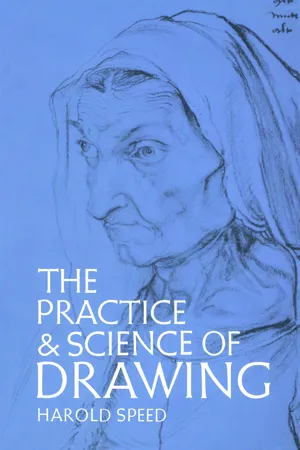
- 400 pages
- English
- ePUB (mobile friendly)
- Available on iOS & Android
The Practice and Science of Drawing
About this book
Much of the learning to practice as well as to appreciate art is concerned with understanding the basic principles. One of these principles is what Harold Speed calls "dither," the freedom that allows realism and the artistic vision to play against each other. Very important to any artist or work of art, this quality separates the scientifically accurate from the artistically accurate. Speed's approach to this problem is now considered a classic, one of the few books from the early years of this century that has continued to be read and recommended by those in the graphic arts.
In this work, Harold Speed approaches this dynamic aspect of drawing and painting from many different points of view. He plays the historical against the scientific, theory against precise artistic definition. He begins with a study of line drawing and mass drawing, the two basic approaches the artist needs to learn. Further sections carry the artistic vision through unity and variety of line and mass, balance, proportion, portrait drawing, the visual memory, materials, and procedures. Throughout, Speed combines historical backgrounds, dynamic aspects which each technique brings to a work of art, and specific exercises through which the young draughtsman may begin his training. Although not a technique book in the strict sense of the terms, The Practice and Science of Drawing brings to the beginner a clear statement of the principles that he will have to develop and their importance in creating a work of art. Ninety-three plates and diagrams, masterfully selected, reinforce Speed's always clear presentation.
Harold Speed, master of the art of drawing and brilliant teacher, has long been cited for this important work. For the beginner, Speed will develop a sense for the many different aspects which go into an artistic education. For the person who enjoys looking at drawings and paintings, Speed will aid developing the ability to see a work of art as the artist meant it to be seen.
Frequently asked questions
- Essential is ideal for learners and professionals who enjoy exploring a wide range of subjects. Access the Essential Library with 800,000+ trusted titles and best-sellers across business, personal growth, and the humanities. Includes unlimited reading time and Standard Read Aloud voice.
- Complete: Perfect for advanced learners and researchers needing full, unrestricted access. Unlock 1.4M+ books across hundreds of subjects, including academic and specialized titles. The Complete Plan also includes advanced features like Premium Read Aloud and Research Assistant.
Please note we cannot support devices running on iOS 13 and Android 7 or earlier. Learn more about using the app.
Information
A CATALOG OF SELECTED DOVER BOOKS IN ALL FIELDS OF INTEREST


100 SMALL HOUSES OF THE THIRTIES, Brown-Blodgett Company. Exterior photographs and floor plans for 100 charming structures. Illustrations of models accompanied by descriptions of interiors, color schemes, closet space, and other amenities. 200 illustrations. 112pp. 8% x 11.







Table of contents
- DOVER BOOKS ON ART INSTRUCTION AND ANATOMY
- Title Page
- Copyright Page
- PREFACE
- Table of Contents
- Table of Figures
- THE PRACTICE AND SCIENCE OF DRAWING - I INTRODUCTION
- II - DRAWING
- III - VISION
- IV - LINE DRAWING
- V - MASS DRAWING
- VI - THE ACADEMIC AND CONVENTIONAL
- VII - THE STUDY OF DRAWING
- VIII - LINE DRAWING: PRACTICAL
- IX - MASS DRAWING: PRACTICAL
- X - RHYTHM
- CHAPTER XI - RHYTHM : VARIETY OF LINE
- XII - RHYTHM: UNITY OF LINE
- XIII - VARIETY OF MASS
- XIV - UNITY OF MASS
- XV - BALANCE
- XVI - RHYTHM: PROPORTION
- XVII - PORTRAIT DRAWING
- XVIII - THE VISUAL MEMORY
- XIX - PROCEDURE
- XX - MATERIALS
- XXI - CONCLUSION
- APPENDIX
- INDEX
- A CATALOG OF SELECTED DOVER BOOKS IN ALL FIELDS OF INTEREST